
- 阻害剤
- 研究分野別
- PI3K/Akt/mTOR
- Epigenetics
- Methylation
- Immunology & Inflammation
- Protein Tyrosine Kinase
- Angiogenesis
- Apoptosis
- Autophagy
- ER stress & UPR
- JAK/STAT
- MAPK
- Cytoskeletal Signaling
- Cell Cycle
- TGF-beta/Smad
- 化合物ライブラリー
- Popular Compound Libraries
- Customize Library
- Clinical and FDA-approved Related
- Bioactive Compound Libraries
- Inhibitor Related
- Natural Product Related
- Metabolism Related
- Cell Death Related
- By Signaling Pathway
- By Disease
- Anti-infection and Antiviral Related
- Neuronal and Immunology Related
- Fragment and Covalent Related
- FDA-approved Drug Library
- FDA-approved & Passed Phase I Drug Library
- Preclinical/Clinical Compound Library
- Bioactive Compound Library-I
- Bioactive Compound Library-II
- Kinase Inhibitor Library
- Express-Pick Library
- Natural Product Library
- Human Endogenous Metabolite Compound Library
- Alkaloid Compound LibraryNew
- Angiogenesis Related compound Library
- Anti-Aging Compound Library
- Anti-alzheimer Disease Compound Library
- Antibiotics compound Library
- Anti-cancer Compound Library
- Anti-cancer Compound Library-Ⅱ
- Anti-cancer Metabolism Compound Library
- Anti-Cardiovascular Disease Compound Library
- Anti-diabetic Compound Library
- Anti-infection Compound Library
- Antioxidant Compound Library
- Anti-parasitic Compound Library
- Antiviral Compound Library
- Apoptosis Compound Library
- Autophagy Compound Library
- Calcium Channel Blocker LibraryNew
- Cambridge Cancer Compound Library
- Carbohydrate Metabolism Compound LibraryNew
- Cell Cycle compound library
- CNS-Penetrant Compound Library
- Covalent Inhibitor Library
- Cytokine Inhibitor LibraryNew
- Cytoskeletal Signaling Pathway Compound Library
- DNA Damage/DNA Repair compound Library
- Drug-like Compound Library
- Endoplasmic Reticulum Stress Compound Library
- Epigenetics Compound Library
- Exosome Secretion Related Compound LibraryNew
- FDA-approved Anticancer Drug LibraryNew
- Ferroptosis Compound Library
- Flavonoid Compound Library
- Fragment Library
- Glutamine Metabolism Compound Library
- Glycolysis Compound Library
- GPCR Compound Library
- Gut Microbial Metabolite Library
- HIF-1 Signaling Pathway Compound Library
- Highly Selective Inhibitor Library
- Histone modification compound library
- HTS Library for Drug Discovery
- Human Hormone Related Compound LibraryNew
- Human Transcription Factor Compound LibraryNew
- Immunology/Inflammation Compound Library
- Inhibitor Library
- Ion Channel Ligand Library
- JAK/STAT compound library
- Lipid Metabolism Compound LibraryNew
- Macrocyclic Compound Library
- MAPK Inhibitor Library
- Medicine Food Homology Compound Library
- Metabolism Compound Library
- Methylation Compound Library
- Mouse Metabolite Compound LibraryNew
- Natural Organic Compound Library
- Neuronal Signaling Compound Library
- NF-κB Signaling Compound Library
- Nucleoside Analogue Library
- Obesity Compound Library
- Oxidative Stress Compound LibraryNew
- Phenotypic Screening Library
- PI3K/Akt Inhibitor Library
- Protease Inhibitor Library
- Protein-protein Interaction Inhibitor Library
- Pyroptosis Compound Library
- Small Molecule Immuno-Oncology Compound Library
- Mitochondria-Targeted Compound LibraryNew
- Stem Cell Differentiation Compound LibraryNew
- Stem Cell Signaling Compound Library
- Natural Phenol Compound LibraryNew
- Natural Terpenoid Compound LibraryNew
- TGF-beta/Smad compound library
- Traditional Chinese Medicine Library
- Tyrosine Kinase Inhibitor Library
- Ubiquitination Compound Library
-
Cherry Picking
You can personalize your library with chemicals from within Selleck's inventory. Build the right library for your research endeavors by choosing from compounds in all of our available libraries.
Please contact us at info@selleck.co.jp to customize your library.
You could select:
- 抗体
- 新製品
- お問い合わせ
EGFR
亜型選択性的な製品
EGFR製品
- All (146)
- EGFR阻害剤 (116)
- EGFR抗体(20)
- EGFR活性剤(1)
- 新製品
| 製品コード | 製品名称 | 製品説明 | 文献中Selleckの製品使用例 | お客様のフィードバック |
|---|---|---|---|---|
| S1025 | Gefitinib (ZD1839) | Gefitinib is an EGFR inhibitor for Tyr1173, Tyr992, Tyr1173 and Tyr992 in the NR6wtEGFR and NR6W cells with IC50 of 37 nM, 37nM, 26 nM and 57 nM, respectively. Gefitinib promotes autophagy and apoptosis of lung cancer cells via blockade of the PI3K/AKT/mTOR pathway. |
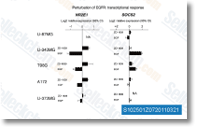
|
|
| S1023 | Erlotinib Hydrochloride | Erlotinib HCl is an EGFR inhibitor with IC50 of 2 nM in cell-free assays, >1000-fold more sensitive for EGFR than human c-Src or v-Abl. |
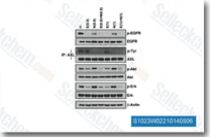
|
|
| S7786 | Erlotinib (CP-358774) | Erlotinib is an EGFR inhibitor with IC50 of 2 nM, >1000-fold more sensitive for EGFR than human c-Src or v-Abl. Erlotinib induces autophagy. |

|
|
| S2111 | Lapatinib | Lapatinib is a potent EGFR and ErbB2 inhibitor with IC50 of 10.8 and 9.2 nM in cell-free assays, respectively. Lapatinib induces ferroptosis and autophagic cell death. |
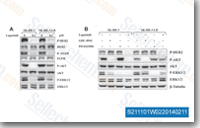
|
|
| S1011 | Afatinib (BIBW2992) | アファチニブ (Afatinib) は in vitro において EGFR/ErbB を不可逆的に阻害します。IC50 は EGFRwt, EGFR L858R , EGFR L858R/T790M ErbB2 (HER2) and ErbB4 (HER4) に対してそれぞれ 0.5, 0.4, 10, 14 および 1 nM です。アファチニブによってオートファジー (autophagy) が誘発されることが報告されています。 |
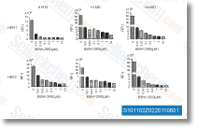
|
|
| S7297 | Osimertinib (AZD9291) | Osimertinib (AZD9291, Mereletinib) is an oral, irreversible, and mutant-selective EGFR inhibitor with IC50 of 12.92, 11.44 and 493.8 nM for Exon 19 deletion EGFR, L858R/T790M EGFR, and WT EGFR in LoVo cells, respectively. Phase 3. |
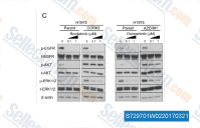
|
|
| S1006 | Saracatinib (AZD0530) | Saracatinib (AZD0530) is a potent Src inhibitor with IC50 of 2.7 nM in cell-free assays, and potent to c-Yes, Fyn, Lyn, Blk, Fgr and Lck; less active for Abl and EGFR (L858R and L861Q). Saracatinib induces autophagy. Phase 2/3. |
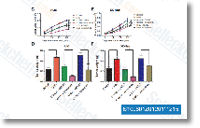
|
|
| S5098 | Gefitinib hydrochloride | Gefitinib (ZD1839) is an EGFR inhibitor with IC50s of 15.5 nM and 823.3 nM for WT EGFR and EGFR (858R/T790M), respectively. | ||
| S7810 | Afatinib Dimaleate | Afatinib Dimaleate irreversibly inhibits EGFR/HER2 including EGFR(wt), EGFR(L858R), EGFR(L858R/T790M) and HER2 with IC50 of 0.5 nM, 0.4 nM, 10 nM and 14 nM, respectively; 100-fold more active against Gefitinib-resistant L858R-T790M EGFR mutant. Afatinib (BIBW2992) Dimaleate induces autophagy. |

|
|
| S1028 | Lapatinib Ditosylate | Lapatinib Ditosylate is a potent EGFR and ErbB2 inhibitor with IC50 of 10.8 and 9.2 nM in cell-free assays, respectively. |
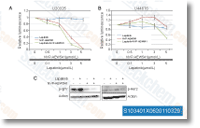
|
|
| S1143 | AG-490 | AG-490 is an inhibitor of EGFR with IC50 of 0.1 μM in cell-free assays, 135-fold more selective for EGFR versus ErbB2, also inhibits JAK2 with no activity to Lck, Lyn, Btk, Syk and Src. |
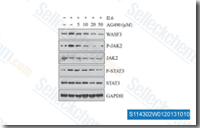
|
|
| S1046 | Vandetanib | Vandetanib is a potent inhibitor of VEGFR2 with IC50 of 40 nM in a cell-free assay. It also inhibits VEGFR3 and EGFR with IC50 of 110 nM and 500 nM, respectively. Not sensitive to PDGFRβ, Flt1, Tie-2 and FGFR1 with IC50 of 1.1-3.6 μM. No activity against MEK, CDK2, c-Kit, erbB2, FAK, PDK1, Akt and IGF-1R with IC50 above 10 μM. Vandetanib (ZD6474) increases apoptosis and induces autophagy by increasing the level of reactive oxygen species (ROS). |
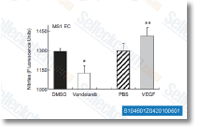
|
|
| S1167 | CP-724714 | CP-724714 is a potent, selective inhibitor of HER2/ErbB2 with IC50 of 10 nM, >640-fold selectivity against EGFR, InsR, IRG-1R, PDGFR, VEGFR2, Abl, Src, c-Met etc in cell-free assays. Phase 2. |
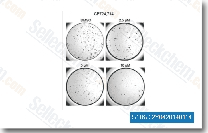
|
|
| S5078 | Osimertinib mesylate | Osimertinib mesylate (AZD9291) is the mesylate form of osimertinib, which is an oral, third-generation epidermal growth factor receptor (EGFR) tyrosine kinase inhibitor (TKI) drug. | ||
| S2150 | Neratinib (HKI-272) | Neratinib is a highly selective HER2 and EGFR inhibitor with IC50 of 59 nM and 92 nM in cell-free assays; weakly inhibits KDR and Src, no significant inhibition to Akt, CDK1/2/4, IKK-2, MK-2, PDK1, c-Raf and c-Met. Phase 3. |
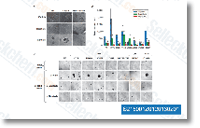
|
|
| S2727 | Dacomitinib | Dacomitinib is a potent, irreversible pan-ErbB inhibitor, mostly to EGFR with IC50 of 6 nM in a cell-free assay. Dacomitinib inhibits ERBB2 and ERBB4 with IC50 of 45.7 nM and 73.7 nM, respectively. Dacomitinib is effective against NSCLCs with EGFR or ERBB2 mutations (resistant to gefitinib) as well as those harboring the EGFR T790M mutation. Dacomitinib inhibits cell growth and induces apoptosis. Phase 2. |
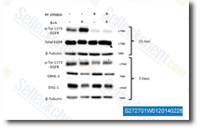
|
|
| S2728 | AG-1478 | AG-1478 is a selective EGFR inhibitor with IC50 of 3 nM in cell-free assays, almost no activity on HER2-Neu, PDGFR, Trk, Bcr-Abl and InsR. AG-1478 (Tyrphostin AG-1478) inhibits encephalomyocarditis virus (EMCV) and hepatitis c virus (HCV) by targeting phosphatidylinositol 4-kinase IIIα (PI4KA). |
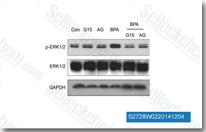
|
|
| S2192 | Sapitinib (AZD8931) | Sapitinib (AZD8931) is a reversible, ATP competitive inhibitor of EGFR, ErbB2 and ErbB3 with IC50 of 4 nM, 3 nM and 4 nM in cell-free assays, more potent against NSCLC cell, 100-fold more selective for the ErbB family than MNK1 and Flt. Phase 2. |
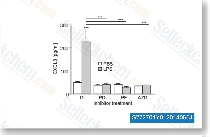
|
|
| S1019 | Canertinib (CI-1033) | Canertinib (CI-1033, PD183805) is a pan-ErbB inhibitor for EGFR and ErbB2 with IC50 of 1.5 nM and 9.0 nM, no activity to PDGFR, FGFR, InsR, PKC, or CDK1/2/4. Phase 3. |
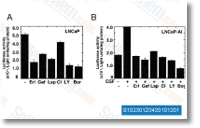
|
|
| A2000 | Cetuximab (anti-EGFR) | Cetuximab, a novel molecular-targeted agent,is an inhibitor of EGFR monoclonal humanized antibody interacting with the extracellular binding site of EGFR to block ligand stimulation. MW : 145.781 KD. |
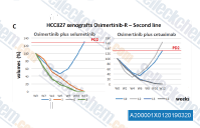
|
|
| S1173 | WZ4002 | WZ4002 is a novel, mutant-selective EGFR inhibitor for EGFR(L858R)/(T790M) with IC50 of 2 nM/8 nM in BaF3 cell line; does not inhibit ERBB2 phosphorylation (T798I). |
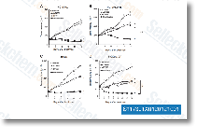
|
|
| S7284 | Rociletinib (CO-1686) | Rociletinib (CO-1686, AVL-301) is an irreversible, mutant-selective EGFR inhibitor with Ki of 21.5 nM and 303.3 nM for EGFRL858R/T790M and EGFRWT in cell-free assays, respectively. Phase 2. |
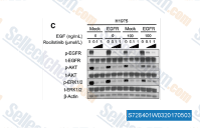
|
|
| S2250 | EGCG ((-)-Epigallocatechin Gallate) | EGCG ((-)-Epigallocatechin Gallate) is the main catechin extraction of green tea that inhibits telomerase and DNA methyltransferase. EGCG blocks the activation of EGF receptors and HER-2 receptors. ECGG inhibits fatty acid synthase and glutamate dehydrogenase activity. |
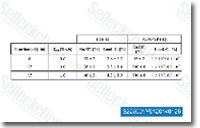
|
|
| S8229 | Brigatinib | Brigatinib is a potent and selective ALK (IC50, 0.6 nM) and ROS1 (IC50, 0.9 nM) inhibitor. It also inhibits IGF-1R, FLT3, and mutant variants of FLT3 (D835Y) and EGFR with lower potentcy. |
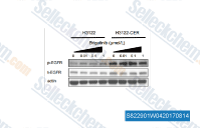
|
|
| S1342 | Genistein | Genistein, a phytoestrogen found in soy products, is a highly specific inhibitor of protein tyrosine kinase (PTK) which blocks the mitogenic effect mediated by EGF on NIH-3T3 cells with IC50 of 12μM. | ||
| S7358 | Poziotinib (HM781-36B) | Poziotinib is an irreversible pan-HER inhibitor with IC50 of 3.2 nM, 5.3 nM and 23.5 nM for HER1, HER2, and HER4, respectively. Poziotinib also induces apoptosis and G1 cell cycle arrest. Phase 2. | ||
| S2205 | DesMethyl Erlotinib (OSI-420) HCl | DesMethyl Erlotinib (OSI-420) HCl is the active metabolite of Erlotinib (EGFR inhibitor with IC50 of 2 nM). |
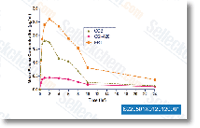
|
|
| S1194 | CUDC-101 | CUDC-101 is a potent multi-targeted inhibitor against HDAC, EGFR and HER2 with IC50 of 4.4 nM, 2.4 nM, and 15.7 nM, and inhibits class I/II HDACs, but not class III, Sir-type HDACs. Phase 1. |
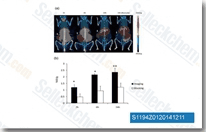
|
|
| S1079 | PD153035 HCl | PD153035 HCl (SU-5271 HCl, AG1517 HCl, ZM 252868 HCl) is a potent and specific inhibitor of EGFR with Ki and IC50 of 5.2 pM and 29 pM in cell-free assays; little effect noted against PGDFR, FGFR, CSF-1, InsR and Src. |
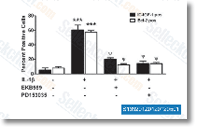
|
|
| S2185 | Allitinib tosylate | Allitinib (AST-1306, AST-6) is a novel irreversible inhibitor of EGFR and ErbB2 with IC50 of 0.5 nM and 3 nM, also effective in mutation EGFR T790M/L858R, more potent to ErbB2-overexpressing cells, 3000-fold selective for ErbB family than other kinases. |
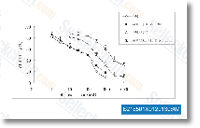
|
|
| S6546 | PD153035 | PD153035 is a specific and potent inhibitor of the epidermal growth factor (EGF) receptor tyrosine kinase (Ki = 5.2 pM). | ||
| S8362 | Tucatinib (Irbinitinib) | Tucatinib (Irbinitinib, ONT-380, ARRY-380) is an orally bioavailable inhibitor of the human epidermal growth factor receptor tyrosine kinase ErbB-2 (also called HER2) with potential antineoplastic activity. | ||
| S1486 | AEE788 (NVP-AEE788) | AEE788 (NVP-AEE788) is a potent inhibitor of EGFR and HER2/ErbB2 with IC50 of 2 nM and 6 nM, less potent to VEGFR2/KDR, c-Abl, c-Src, and Flt-1, does not inhibit Ins-R, IGF-1R, PKCα and CDK1. Phase 1/2. |
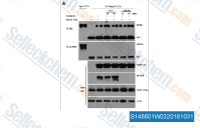
|
|
| S2867 | WHI-P154 | WHI-P154 is a potent JAK3 inhibitor with IC50 of 1.8 μM, no activity against JAK1 or JAK2, also inhibits EGFR, Src, Abl, VEGFR and MAPK, prevents Stat3, but not Stat5 phosphorylation. |
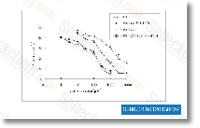
|
|
| S1392 | Pelitinib (EKB-569) | Pelitinib (EKB-569) is a potent irreversible EGFR inhibitor with IC50 of 38.5 nM. Pelitinib (EKB-569) also slightly inhibits Src, MEK/ERK and ErbB2 with IC50s of 282 nM, 800 nM and 1255 nM, respectively. Phase2. |
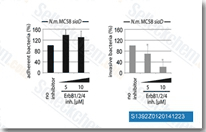
|
|
| S1056 | AC480 (BMS-599626) | AC480 (BMS-599626) is a selective and efficacious inhibitor of HER1 and HER2 with IC50 of 20 nM and 30 nM, ~8-fold less potent to HER4, >100-fold to VEGFR2, c-Kit, Lck, MET etc. Phase 1. |
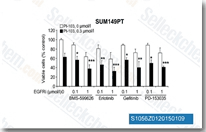
|
|
| S2755 | Varlitinib | Varlitinib (ARRY334543) is a selective and potent ErbB1(EGFR) and ErbB2(HER2) inhibitor with IC50 of 7 nM and 2 nM, respectively. Phase 2. |
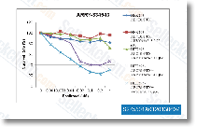
|
|
| S0711 | Canertinib dihydrochloride | Canertinib (CI-1033, PD-183805, compound 18) dihydrochloride is a potent and irreversible inhibitor of epidermal growth factor receptor (EGFR) tyrosine kinase. Canertinib dihydrochloride inhibits cellular EGFR and ErbB2 autophosphorylation with IC50 of 7.4 nM and 9 nM, respectively. | ||
| S2922 | Icotinib (BPI-2009H) | Icotinib (BPI-2009H) is a potent and specific EGFR inhibitor with IC50 of 5 nM, including the EGFR, EGFR(L858R), EGFR(L861Q), EGFR(T790M) and EGFR(T790M, L858R). |
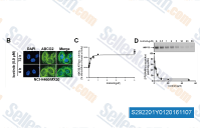
|
|
| S7824 | Nazartinib (EGF816) | Nazartinib (EGF816, NVS-816) is a covalent, irreversible, mutant-selective EGFR inhibitor that has nanomolar inhibitory potency against activating mt (L858R, ex19del) and T790M mt, with up to 60-fold selectivity over wild type (wt) EGFR in vitro. | ||
| S7926 | Lifirafenib (BGB-283) | Lifirafenib (BGB-283, Beigene-283) potently inhibits RAF family kinases and EGFR activities in biochemical assays with IC50 values of 23, 29 and 495 nM for the recombinant BRAFV600E kinase domain, EGFR and EGFR T790M/L858R mutant. | ||
| S8312 | NSC228155 | NSC228155 is an activator of EGFR. It binds to the sEGFR dimerization domain II and modulates EGFR tyrosine phosphorylation. | ||
| S7000 | AP26113-analog (ALK-IN-1) | AP26113-analog (ALK-IN-1) is an analog of AP26113 which is a potent and selective ALK inhibitor. It is also an inhibitor of EGFR. |
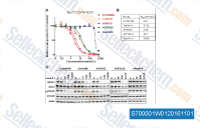
|
|
| S7039 | PD168393 | PD168393 is an irreversible EGFR inhibitor with IC50 of 0.70 nM, irreversibly alkylate Cys-773; inactive against insulin, PDGFR, FGFR and PKC. |
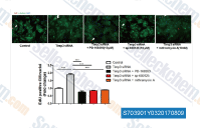
|
|
| S8294 | Olmutinib (BI 1482694) | Olmutinib (BI 1482694) is a novel third-generation epidermal growth factor receptor (EGFR) mutation-specific tyrosine kinase inhibitor (TKI). Also a potent inhibitor of Bruton's tyrosine kinase. | ||
| S7971 | Zorifertinib (AZD3759) | Zorifertinib (AZD3759) is a potent, oral active, CNS-penetrant EGFR inhibitor with IC50 of 0.3 nM, 0.2 nM, and 0.2 nM for EGFR (WT), EGFR (L858R), and EGFR (exon 19Del), respectively. Phase 1. | ||
| S2784 | TAK-285 | TAK-285 is a novel dual HER2 and EGFR(HER1) inhibitor with IC50 of 17 nM and 23 nM, >10-fold selectivity for HER1/2 than HER4, less potent to MEK1/5, c-Met, Aurora B, Lck, CSK etc. Phase 1. | ||
| S2554 | Daphnetin | Daphnetin, a natural coumarin derivative, is a protein kinase inhibitor, inhibits EGFR, PKA and PKC with IC50 of 7.67 μM, 9.33 μM and 25.01 μM, respectively, also known to exhibit anti-inflammatory and anti-oxidant activities. |
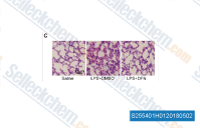
|
|
| S7298 | AZ5104 | AZ5104, the demethylated metabolite of AZD-9291, is a potent EGFR inhibitor with IC50 of <1 nM, 6 nM, 1 nM, and 25 nM for EGFR (L858R/T790M), EGFR (L858R), EGFR (L861Q), and EGFR (wildtype), respectively. Phase 1. | ||
| S8724 | Lazertinib | Lazertinib (YH25448,GNS-1480) is a potent, highly mutant-selective and irreversible EGFR-TKI with IC50 values of 1.7 nM, 2 nM, 5 nM, 20.6 nM and 76 nM for Del19/T790M, L858R/T790M, Del19, L85R and Wild type EGFR respectively, showing much higher IC50 values aganist ErbB2 and ErbB4. | ||
| S7557 | CL-387785 (EKI-785) | CL-387785 (EKI-785, WAY-EKI 785) is an irreversible, and selective EGFR inhibitor with IC50 of 370 pM. |
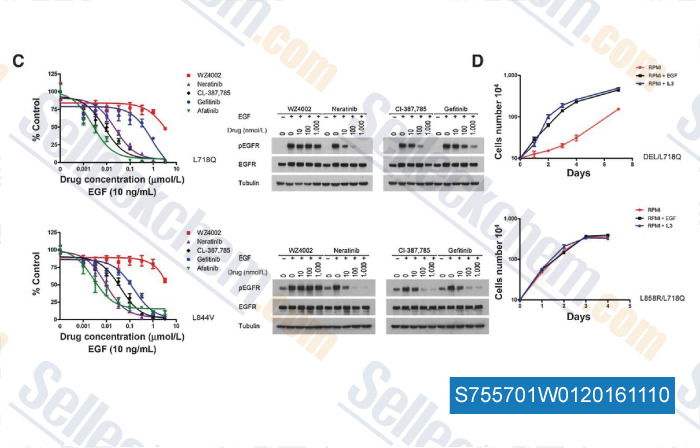
|
|
| S8852 | Pyrotinib dimaleate | Pyrotinib dimaleate is a potent and selective irreversible dual tyrosine kinase inhibitor of EGFR and HER2 with IC50 of 0.013 μM and 0.038 μM, respectively. | ||
| S1179 | WZ8040 | WZ8040 is a novel mutant-selective irreversible EGFRT790M inhibitor, does not inhibit ERBB2 phosphorylation (T798I). |
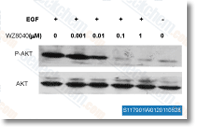
|
|
| S7206 | CNX-2006 | CNX-2006 is a novel irreversible mutant-selective EGFR inhibitor with IC50 of < 20 nM, with very weak inhibition at wild-type EGFR. |

|
|
| S6813 | Mobocertinib (TAK788) | Mobocertinib (TAK788, AP32788), an investigational TKI, is a potent, selective preclinical inhibitor of epidermal growth factor receptor (EGFR) and HER2 mutations. Mobocertinib (TAK788) is an antineoplastic agent. | ||
| S6868 | Alflutinib (Furmonertinib) mesylate | Alflutinib (Furmonertinib) mesylate is a third-generation epidermal growth factor receptor (EGFR) inhibitor that inhibits both EGFR-sensitive mutations and T790M mutations. Alflutinib (AST2818), primarily metabolized by CYP3A4, is also a potent CYP3A4 inducer with EC50 of 0.25 μM. | ||
| S0360 | EGFR Inhibitor | EGFR inhibitor, a cell permeable, 4,6-disubstituted pyrimidine compound, is a highly selevtive inhibitor of EGFR kinase with IC50 of 21 nM. EGFR inhibitor directly depolymerizes microtubules and is used as a chemical probe to investigate both the EGFR pathway and microtubule dynamics. | ||
| S2406 | Chrysophanic Acid | Chrysophanic Acid (Chrysophanol), a natural anthraquinone isolated from Dianella longifolia, is a EGFR/mTOR pathway inhibitor. |
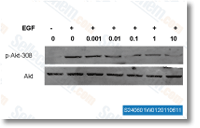
|
|
| S3759 | Norcantharidin | Norcantharidin (Endothall anhydride) is a synthetic anticancer compound which is a dual inhibitor for c-Met and EGFR in human colon cancers. | ||
| S8036 | Butein | Butein, a plant polyphenol isolated from Rhus verniciflua, is able to inhibit the activation of protein tyrosine kinase, NF-κB and STAT3, also inhibits EGFR. | ||
| S9414 | Cyasterone | Cyasterone is the main phytoecdysteroid component found in Cyathula capitata. It is a natural EGFR inhibitor and maybe a promising anti-cancer agent. | ||
| S8741 | Avitinib (Abivertinib) | Avitinib (Abivertinib) is a pyrrolopyrimidine-based irreversible EGFR inhibitor that is mutation-selective with IC50 value of 0.18 nM against EGFR L858R/T790M double mutations, nearly 43-fold greater potency over wild-type EGFR (IC50 value, 7.68 nM). It has comparable anti-tumor activity and tolerated toxicity. | ||
| S1170 | WZ3146 | WZ3146 is a mutant-selective irreversible inhibitor of EGFR(L858R) and EGFR(E746_A750) with IC50 of 2 nM and 2 nM; does not inhibit ERBB2 phosphorylation (T798I). |
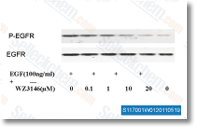
|
|
| S2752 | HER2-Inhibitor-1 | HER2-Inhibitor-1 is an analog of ARRY-380. ARRY-380 is a potent and selective HER2 inhibitor with IC50 of 8 nM, equipotent against truncated p95-HER2, 500-fold more selective for HER2 versus EGFR. |

|
|
| S2895 | Tyrphostin 9 | Tyrphostin 9 (SF 6847, RG-50872) is firstly designed as an EGFR inhibitor with IC50 of 460 μM, but is also found to be more potent to PDGFR with IC50 of 0.5 μM. | ||
| S8009 | AG-18 | AG-18 (RG-50810, Tyrphostin A23, TX 825) inhibits EGFR with IC50 of 35 μM. | ||
| A2018 | Panitumumab (anti-EGFR) | Panitumumab (anti-EGFR, ABX-EGF) is a recombinant, fully human IgG2 monoclonal antibody that binds to the epidermal growth factor receptor (EGFR). | ||
| S6541 | MTX-211 | MTX-211 is a first-in-class dual inhibitor of PI3K and EGFR kinase. | ||
| S8412 | Naquotinib(ASP8273) | Naquotinib (ASP8273) is an orally available, irreversible, mutant-selective, epidermal growth factor receptor (EGFR) inhibitor, with potential antineoplastic activity. | ||
| S9786 | Tuxobertinib (BDTX-189) | Tuxobertinib (BDTX-189) is a potent and selective inhibitor of allosteric EGFR and HER2 oncogenic mutations with Kd of 0.2 nM, 0.76 nM, 13 nM and 1.2 nM for EGFR, HER2, BLK and RIPK2, reapectively. BDTX-189 exhibits anticancer activity. | ||
| S4667 | Lidocaine hydrochloride | Lidocaine hydrochloride (Lidothesin, Lignocaine, Xyloneural) is an inhibitor of epidermal growth factor receptor (EGFR) and has antiproliferative effect on human tongue cancer cells. Lidocaine hydrochloride is a local anesthetic and cardiac depressant used as an antiarrhythmia agent. | ||
| E0368 | (S)-Sunvozertinib ((S)-DZD9008) | (S)-Sunvozertinib ((S)-DZD9008) is an oral, potent, irreversible, wild type-selective EGFR inhibitor against EGFR or HER2 Exon20ins and other mutations with IC50 ranging from 0.4 nM to 2.1 nM for mutant EGFR. | ||
| S8242 | EAI045 | EAI045 is an allosteric inhibitor that targets selected drug-resistant EGFR mutants but spares the wild-type receptor. | ||
| S8814 | zipalertinib (TAS6417) | zipalertinib (TAS6417) is a novel EGFR inhibitor that targets EGFR exon 20 insertion mutations while sparing wild-type (WT) EGFR. IC50 values ranges from 1.1 ± 0.1 to 8.0 ± 1.1 nmol/L. | ||
| S8817 | Almonertinib (HS-10296) | Almonertinib (HS-10296) is a small molecule inhibitor of EGFR-activating mutations and T790M-resistant mutation with limited activity against wild-type EGFR. | ||
| F0053New | EGF Receptor Antibody [K22M8] | EGF Receptor Rabbit mAb recognizes endogenous levels of total EGF Receptor protein. | ||
| F0298 | Phospho-EGF Receptor (Tyr1068) Antibody [J6N1] | |||
| F1394 | Phospho-EGF Receptor (Thr669) Antibody [H18D23] | |||
| F0433 | HER3/ErbB3 Antibody [J23H19] | |||
| F1282 | Eps15 Antibody [D10D13] | |||
| E4449 | AG 825 | AG-825 (Tyrphostin AG-825) is a potent and selective inhibitor of ErbB2 with IC50 values of 0.15 µM. It also inhibits PDGFR autophosphorylation with IC50 value of 40 µM. It exhibits anti-cancer activity and significantly induces apoptosis in cancer cells. | ||
| E1749 | limertinib | limertinib (ASK120067) is an irreversible third-generation inhibitor of EGFRT790M with IC50 of 0.3 nM, with selectivity over EGFRWT having IC50 of 6.0 nM. It exhibits potent anti-proliferation activity in non-small cell lung cancer (NSCLC) tumor cells. | ||
| S6899 | Licochalcone D | Licochalcone D (Lico D, LCD, LD), a flavonoid isolated from a Chinese medicinal plant Glycyrrhiza inflata, has antioxidant, anti-inflammatory and anti-cancer properties. Licochalcone D inhibit phosphorylation of NF-κB p65 in LPS signaling pathway. Licochalcone D inhibits JAK2, EGFR and Met (c-Met) activities and induces ROS-dependent apoptosis. Licochalcone D also induces caspases activation and poly (ADP-ribose) polymerase (PARP) cleavage. | ||
| S6525 | AG 555 | AG-555 (Tyrphostin B46) is an inhibitor of tyrosine kinase, interacts directly with topoisomerase I, thus preventing DNA relaxation. It inhibits EGFR with an IC50 of 0.7 μM. | ||
| E1176 | BLU-945 | BLU-945 effectively inhibits EGFR with L858R and/or exon 19 deletion mutation, T790M mutation, and C797S mutation. BLU-945 facilitates efficacious dosing and reduces EGFR-mediated on-target toxicities. S BLU-945 has the potential for the research of cancer disease (extracted from patent WO2021133809A1, compound 112). |
||
| E4819 | Afatinib free base | Afatinib free base (Gilotrif, BIBW2992, Boehringer Ingelheim) is a second-generation tyrosine kinase inhibitor (TKI) that irreversibly inhibits EGFR and HER2, with IC50 of 0.5 nM, 0.4 nM, 14 nM and 1 nM for wild-type EGFR, EGFR-L858R, HER2, ErbB4, respectively. | ||
| E5906New | Sunvozertinib | Sunvozertinib (DZD9008) is an oral, potent, and selective inhibitor of ErbBs (EGFR or Her2), particularly mutant forms of ErbBs. It also inhibits EGFR exon 20 NPH insertion, EGFR exon 20 ASV insertion, EGFR L858R and T790M mutations, Her2 exon 20 YVMA, and EGFR WT A431, with IC50 values of 20.4 nM, 20.4 nM, 1.1 nM, 7.5 nM, and 80.4 nM, respectively. | ||
| S6805 | Tyrphostin AG-528 | Tyrphostin AG-528 (Tyrphostin B66) is a potent inhibitor of epidermal growth factor receptors (EGFR) and ErbB2/HER2 with IC50 of 4.9 μM and 2.1 μM, respectively. Tyrphostin AG-528 exhibits anticancer activity. | ||
| E5912New | Asandeutertinib | Asandeutertinib (Osimertinib-d3, AZD-9291-d3) is an orally administered, ATP-competitive, irreversible, deuterated third-generation Epidermal Growth Factor Receptor Tyrosine Kinase Inhibitor (EGFR TKI) and a deuterium-stabilized derivative of osimertinib, with the potential to treat advanced EGFR-mutated NSCLC. | ||
| S6509 | AG 494 | AG-494, a member of the tyrphostin family of tyrosine kinase inhibitors, is a potent inhibitor of EGF receptor autophosphorylation (IC50=1.2 μM) and EGF-dependent cell growth (IC50=6 μM). | ||
| S0736 | AG 556 | AG-556 is a potent EGFR tyrphostin inhibitor with an IC50 of 5µM which suppresses the EGF-induced growth of HER14 cell. | ||
| A2048 | Necitumumab (anti-EGFR) | Necitumumab (anti-EGFR) is an epidermal growth factor receptor (EGFR) antagonist that can be used in combination with gemcitabine and cisplatin for the first-line treatment of patients with metastatic squamous non-small cell lung cancer. | ||
| S6523 | RG14620 | RG14620 (Tyrphostin RG14620), an EGFR inhibitor of the tyrphostin family, directly inhibits the transport function of ABCG2/BCRP. | ||
| A2601 | Amivantamab (Anti-HGFR / c-Met) | Amivantamab (Anti-HGFR/c-Met) is an antibody targeting hepatocyte growth factor receptor (HGFR, also known as c-Met) with immunohistochemical activity against non-small cell lung cancer (NSCLC). MW :145.88 KD. | ||
| S6530 | EBE-A22 | EBE-A22 is a derivative of PD 153035 which can inhibit ErbB-1-phosphorylation, whereas EBE-A22 is inactive. | ||
| E1877 | Pebezertinib | Pebezertinib is a central nervous system (CNS)-penetrant, wild-type EGFR-sparing, covalent inhibitor of epidermal growth factor receptor (EGFR) exon 20 insertion (Ex20ins) with an IC50 of 7-78 nM. It also exhibits a potent anti-tumor efficacy. | ||
| A2878 | Gancotamab (Anti-ERBB2 / HER2 / CD340) | Gancotamab (Anti-ERBB2 / HER2 / CD340) is a HER2-targeted PEGylated liposome that encapsulates doxorubicin to facilitate its delivery to HER2-overexpressing tumor cells. MW: 143.6 KD. | ||
| S0070 | Gefitinib-based PROTAC 3 | Gefitinib-based PROTAC 3 which conjugates an EGFR binding element to a VHL ligand via a linker induces degradation of EGFR and mutants with DC50 of 11.7 nM and 22.3 nM in HCC827(Exon 19 del) and H3255 (L858R) cells, respectively. | ||
| A2886 | Demupitamab (Anti-ERBB1 / EGFR / HER1) | Demupitamab (Anti-ERBB1 / EGFR / HER1) is a humanized monoclonal antibody (MoAb) against the human epidermal growth factor receptor (EGFR). MW: 144.8 KD. | ||
| A2887 | Depatuxizumab (Anti-ERBB1 / EGFR / HER1) | Depatuxizumab (anti-ERBB1/ EGFR / HER1) is a humanized monoclonal antibody (MoAb) against the human epidermal growth factor receptor (EGFR) with antineoplastic activity. MW: 144.54 KD. | ||
| A2889 | Imgatuzumab (Anti-ERBB1 / EGFR / HER1) | Imgatuzumab (Anti-ERBB1 / EGFR / HER1) is a glycoengineered monoclonal antibody directed against the epidermal growth factor receptor (EGFR) with potential antineoplastic activity. MW: 145.28 KD. | ||
| A2890 | Laprituximab (Anti-ERBB1 / EGFR / HER1) | Laprituximab (Anti-ERBB1/ EGFR / HER1) is a humanized IgG1 monoclonal antibody against epidermal growth factor receptor (EGFR) with anti-tumor activity. MW: 145.2 KD. | ||
| A2891 | Matuzumab (Anti-ERBB1 / EGFR / HER1) | Matuzumab (anti-ERBB1/ EGFR / HER1) is a humanized anti-epidermal growth factor receptor (EGFR) monoclonal antibody that blocks EGFR activation, downstream signalling, and inhibits tumor growth. MW: 145.9 KD. | ||
| S0324 | Tyrphostin AG30 (AG30) | Tyrphostin AG30 (AG30), a potent and selective EGFR tyrosine kinase inhibitor, selectively inhibits self renewal induction by c-ErbB, and is able to inhibit activation of STAT5 by c-ErbB in primary erythroblasts. | ||
| A2893 | Pimurutamab (Anti-ERBB1 / EGFR / HER1) | Pimurutamab (Anti-ERBB1 / EGFR / HER1) is a glycoengineered humanized monoclonal antibody against epidermal growth factor receptor (EGFR) potential antineoplastic activity. MW: 144.92 KD. | ||
| A2895 | Zalutumumab (Anti-ERBB1 / EGFR / HER1) | Zalutumumab (Anti-ERBB1 / EGFR / HER1) is a fully human IgG1 monoclonal antibody against epidermal growth factor receptor (EGFR) with potential antineoplastic activity. MW: 146.52 KD. | ||
| A2898 | Hersintuzumab (Anti-ERBB2 / HER2 / CD340) | Hersintuzumab (Anti-ERBB2 / HER2 / CD340) is a humanized monoclonal antibody that targets human epidermal growth factor receptor 2 (HER2), extracellular domains I–II, with antitumor activity in ovarian cancer. MW: 144.26 KD. | ||
| A2900 | Timigutuzumab (Anti-ERBB2 / HER2 / CD340) | Timigutuzumab (Anti-ERBB2 / HER2 / CD340) is a humanized immunoglobulin that targets the extracellular domain of the human epidermal growth factor receptor 2 (ErbB2, also known as HER2). Timigutuzumab can be used for cancer research. MW: 150 KD. | ||
| A2901 | Barecetamab (Anti-ERBB3 / HER3) | Barecetamab (Anti-ERBB3/HER3) is a fully human antibody directed against the receptor tyrosine-protein kinase erbB-3 (ErbB3; HER3) with antineoplastic activity. It has the potential to be used in research on recurrent/metastatic (R/M) head and neck squamous cell carcinoma (HNSCC). MW: 137.96 KD. | ||
| A2902 | Lumretuzumab (Anti-ERBB3 / HER3) | Lumretuzumab (Anti-ERBB3 / HER3) is an immunoconjugate containing a glycoengineered, humanized monoclonal antibody directed against the human epidermal growth factor receptor HER3 (ErbB3) with potential antineoplastic activity. MW: 147.16 KD. | ||
| E0344 | ErbB2 inhibitor | ErbB-2 Inhibitor is a EGFR, ErbB2 and ErbB4 inhibitor with IC50s of 0.017 μM, 0.08 μM, 1.91 μM. | ||
| E4597 | Avitinib maleate | Avitinib maleate(Abivertinib maleate, AC0010 maleate, AC0010MA) is a third-generation, irreversible, and orally active selective inhibitor of EGFR. It displays IC50 values of 0.18 nM, 0.18 nM, 7.68 nM and against EGFR L858R, EGFR T790M, and wild-type EGFR. Avitinib maleate also acts as an inhibitor of BTK that induces apoptosis of BTK in mantle cell lymphoma. | ||
| E4664 | Osimertinib dimesylate | Osimertinib dimesylate (Mereletinib dimesylate, AZD-9291 dimesylate) is a potent, mutant-selective, irreversible inhibitor of EGFR kinase activity with an IC50s of 12 and 1 nM against EGFRL858R and EGFRL858R/T790M, respectively. It demonstrates anti-tumor activity in xenograft and transgenic T790M EGFR mutant models, supporting its use in non-small cell lung cancer (NSCLC) research. | ||
| A2927 | Losatuxizumab (Anti-ERBB1 / EGFR / HER1) | Losatuxizumab (ABT-806) is a human monoclonal antibody against EGFR with anti-tumour activity. MW: 144.8 KD. | ||
| S6698 | TQB3804 | TQB3804 is a selective and potent EGFR kinase inhibitor with IC50 of 0.46 nM, 0.13 nM, 0.26 nM, 0.19 nM and 1.07 nM for for EGFRd746-750/T790M/C797S, EGFRL858R/T790M/C797S, EGFRd746-750/T790M, EGFRL858R/T790M and EGFRWT, respectively. TQB3804 (EGFR-IN-7) shows anti-tumor activity. | ||
| A2936 | Modotuximab (Anti-ERBB1 / EGFR / HER1) | Modotuximab (Anti-ERBB1 / EGFR / HER1) is a recombinant immunoglobulin G1 (IgG1) monoclonal antibody directed against the epidermal growth factor receptor (EGFR) with potential antineoplastic activity. MW: 146.6 KD. | ||
| S3879 | Kaempferide | Kaempferide (4'-Methylkaempferol, 4'-O-Methylkaempferol, Kaempferol 4'-methyl ether), a natural compound derived from the roots of kaempferia galanga, has a variety of effects including anti-carcinogenic, anti-inflammatory, anti-oxidant, anti-bacterial and anti-viral properties. | ||
| A2944 | Nimotuzumab (Anti-ERBB1 / EGFR / HER1) | Nimotuzumab (Anti-ERBB1 / EGFR / HER1) is a humanized monoclonal antibody directed against the epidermal growth factor receptor (EGFR) with potential antineoplastic activity. MW: 147.58 KD. | ||
| S2733 | AV-412 free base | AV-412 free base (MP-412 free base) is an EGFR inhibitor with IC50s of 0.75, 0.51, 0.79, 2.30, 19 nM for EGFR, EGFRL858R, EGFRT790M, EGFRL858R/T790M and ErbB2, respectively. | ||
| E0822 | AST-1306 | AST-1306 (Allitinib) is an orally active and irreversible EGFR, ErbB2 and inhibitor with IC50s of 0.5, 3 and 0.8 nM, respectively. | ||
| S8920 | (Rac)-JBJ-04-125-02 | (Rac)-JBJ-04-125-02 (JBJ-04-125-02 racemate) is a mutant-selective allosteric inhibitor of Epidermal growth factor receptor (EGFR) with potential anticancer activity. | ||
| S6881 | JND3229 | JND3229 is a potent reversible inhibitor of EGFRC797S with an IC50 value of 5.8 nM. JND3229 also potently suppresses EGFRL858R/T790M and EGFRWT with IC50 values of 30.5 nM and 6.8 nM, respectively. | ||
| S8921 | BI-4020 | BI-4020 is an orally active, non-covalent EGFR inhibitor with IC50 of 0.6 nM and 0.2 nM for EGFRdel19 T790M C797S as biomarker potency and anti-proliferation potency in BaF3 cells, respectively. | ||
| S1054 | AG99 | AG99 (Tyrphostin 46,Tyrphostin A46,Tyrphostin B40) is a potent and selective inhibitor of EGFR. | ||
| S8584 | Theliatinib (HMPL-309) | Theliatinib (HMPL-309) is a highly potent EGFR inhibitor with Ki value of 0.05 nM against the wild type EGFR and IC50 values of 3 nM and 22 nM against EGFR and EGFR T790M/L858R mutant. It demonstrats 50 fold greater selectivity for EGFR compared to 72 other kinases. | ||
| E6000New | BIEGi-1 | BIEGi-1 is a potent and selective binary inhibitor of EGFR that effectively blocks EGFR-catalyzed nucleotide exchange and disrupts the EGFR–Rheb interaction. It robustly inhibits both EGFR kinase activity and mTORC1 signaling in EGFR-mutant cancer cells. BIEGi-1 exhibits significant anti-proliferative effects with an IC50 of 17 nM for PC9 and 20 nM for HCC827. | ||
| S0151 | AG-1557 | AG-1557 is a specific and ATP competitive inhibitor of epidermal growth factor receptor (EGFR) tyrosine kinase. | ||
| S2115 | RG 13022 | RG 13022 (Tyrphostin RG13022) inhibits the autophosphorylation reaction of the EGF receptor in immunoprecipitates with IC50 of 4 µM. | ||
| E4884 | Icotinib Hydrochloride | Icotinib hydrochloride (BPI-2009H) is a highly potent and selective epidermal growth factor receptor tyrosine kinase inhibitor (EGFR-TKI) with an IC50 of 5 nM, utilized in the treatment of non-small cell lung cancer (NSCLC). | ||
| E1478 | BDTX-1535 | BDTX-1535 (EGFR-IN-76) is an orally available, highly potent, selective, and irreversible EGFR inhibitor that can penetrate the blood-brain barrier, with the potential to treat Glioblastoma or Non-Small Cell Lung Cancer. | ||
| E1919New | Befotertinib mesylate | Befotertinib mesylate (D-0316 mesylate) is third-generation tyrosine kinase inhibitor (TKI) of EGFR . It can be used for the research of EGFR T790M-positive non-small cell lung cancer (NSCLC). | ||
| E2399 | Falnidamol | Falnidamol (BIBX1382) is a selective inhibitor of epidermal growth factor receptor (EGFR), exerting anti-cancer role in human head and neck squamous cell carcinomas both in vitro and in vivo through suppressing mitogen-activated protein kinases (MAPKs) signaling. | ||
| E0833 | O-Demethyl-Gefitinib | O-Desmethyl gefitinib, a major active metabolite of gefitinib, is a potent EGFR (ErbB1/HER1) inhibitor, inhibits subcellular EGFR tyrosine kinase through a mechanism similar to that of gefitinib with IC50 values of 36 and 22 nM, respectively. | ||
| D4022 | Cetuximab-MMAE | Cetuximab-MMAE is an antibody-drug conjugate composed of a anti-EGFR monoclonal antibody and a cytotoxic tubulin polymerase inhibitor conjugated through MC-Vc-PAB (maleimidocaproyl-valine-citrulline-p-aminobenzoyloxycarbonyl) type linker. | ||
| D4027 | Serclutamab talirine | Serclutamab Talirine (ABBV-321), is an antibody-drug conjugate (ADC) composed of an humanized immunoglobulin G1 anti-EGFR monoclonal antibody conjugated to a pyrrolobenzodiazepine (PBD) dimer via a maleimidocaproyl-valine-alanine linker. Serclutamab Talirine has the potential for use in advanced solid tumors associated with overexpression of the epidermal growth factor receptor (EGFR) or its ligands. | ||
| E4680 | MTX-531 | MTX-531(NSC827271) is a first-in-class, potent and selective inhibitor of EGFR and PI3Kα with an IC50 of 14.7 nM and 6.4 nM, respectively. It may play a role in treating Head and Neck Squamous Cell Carcinoma (HSNCC), squamous lung cancers, and certain EGFR/PI3K-driven triple-negative breast cancers. | ||
| E4675 | Rezivertinib | Rezivertinib(BPI-7711) is a potent third-generation inhibitor of EGFR tyrosine kinase, targeting both EGFR-sensitizing mutations and the EGFR T790M mutation. Additionally, it has excellent CNS penetration and has antitumor activity. | ||
| D4037 | Laprituximab emtansine | Laprituximab emtansine (IMGN-289) is an anti-EGFR (epidermal growth factor receptor, receptor tyrosine-protein kinase erbB-1, ERBB1, HER1, HER-1, ERBB), chimeric monoclonal antibody conjugated to maytansinoid DM1 via a succinimidyl-4-(N-maleimidomethyl) cyclohexane-1-carboxylate (SMCC) linker, forming a nonreducible thioether bond. | ||
| S6897 | Epertinib hydrochloride | Epertinib hydrochloride (S-222611 hydrochloride) is a potent, orally active, reversible, and selective tyrosine kinase inhibitor of EGFR, HER2 and HER4 with IC50 of 1.48 nM, 7.15 nM and 2.49 nM, respectively. Epertinib hydrochloride (S-222611 hydrochloride) exhibits antitumor activity. | ||
| E4886 | HS-10296 hydrochloride | HS-10296 hydrochloride(Almonertinib (hydrochloride), HS-10296 HCl) is an irreversible, third-generation inhibitor of EGFR tyrosine kinase that demonstrates high selectivity for EGFR-sensitizing mutations, T790M resistance mutation. It exhibits inhibitory activity against T790M, T790M/L858R, and T790M/Del19, with IC50 of 0.37 nM, 0.29 nM, and 0.21 nM, respectively. It also exhibits anti-tumor activity. | ||
| S6809 | SU5214 | SU5214 is an inhibitor of VEGF receptor 2 (VEGFR2/FLK-1) with IC50 of 14.8 µM and EGFR with IC50 of 36.7 µm, respectively. | ||
| D4042 | Depatuxizumab mafodotin | Depatuxizumab Mafodotin (Depatux-M, ABT-414) is an antibody-drug conjugate consisting of an EGFR IGg1 monoclonal antibody conjugated to the tubulin inhibitor monomethyl auristatin F via a stable maleimidocaproyl link. Depatuxizumab Mafodotin is used in the treatment of recurrent EGFR-amplified Glioblastoma (GBM). | ||
| D4049 | Disitamab vedotin | Disitamab Vedotin (RC-48 ,RC 480-ADC) is an antibody-drug conjugate(ADC) composed of anti-[ERBB2 (epidermal growth factor receptor 2, receptor tyrosine-protein kinase erbB-2, EGFR2, HER2, HER-2, p185c-erbB2, NEU, CD340)] humanized monoclonal antibody, conjugated to monomethylauristatin E (MMAE), via a cleavable maleimidocaproyl-valyl-citrullinyl-p-aminobenzyloxycarbonyl (mc-val-cit-PABC) type linker. Disitamab Vedotin has the potential for use in solid tumors mainly in advanced breast cancer. | ||
| E4904 | Dacomitinib hydrate | Dacomitinib hydrate(PF-00299804, PF-804) is an orally administered, highly selective irreversible inhibitor targeting pan-ERBB receptors, with an IC50 of 6.0 nM for EGFR, 45.7 nM for ERBB2, and 73.7 nM for ERBB4. It also demonstrates anti-tumor activity. | ||
| E2980 | 4-AMino-1-phenylpyrazolo[3,4-d]pyriMidine | 4-AMino-1-phenylpyrazole[3,4-d]pyriMidine(PP 3) is an EGFR tyrosine kinase inhibitor with an IC50 of 2.7 μM. It is a negative control for the Src kinase inhibitor, PP 2. | ||
| A2810 | Coprelotamab (Anti-ERBB2 / HER2 / CD340) | Coprelotamab (Anti-ERBB2 / HER2 / CD340) is humanized monoclonal antibody targated against HER2 with the potential to treat breast cancer. MW : 145.36 KD. | ||
| S1025 | Gefitinib (ZD1839) | Gefitinib is an EGFR inhibitor for Tyr1173, Tyr992, Tyr1173 and Tyr992 in the NR6wtEGFR and NR6W cells with IC50 of 37 nM, 37nM, 26 nM and 57 nM, respectively. Gefitinib promotes autophagy and apoptosis of lung cancer cells via blockade of the PI3K/AKT/mTOR pathway. |

|
|
| S1023 | Erlotinib Hydrochloride | Erlotinib HCl is an EGFR inhibitor with IC50 of 2 nM in cell-free assays, >1000-fold more sensitive for EGFR than human c-Src or v-Abl. |

|
|
| S7786 | Erlotinib (CP-358774) | Erlotinib is an EGFR inhibitor with IC50 of 2 nM, >1000-fold more sensitive for EGFR than human c-Src or v-Abl. Erlotinib induces autophagy. |

|
|
| S2111 | Lapatinib | Lapatinib is a potent EGFR and ErbB2 inhibitor with IC50 of 10.8 and 9.2 nM in cell-free assays, respectively. Lapatinib induces ferroptosis and autophagic cell death. |

|
|
| S1011 | Afatinib (BIBW2992) | アファチニブ (Afatinib) は in vitro において EGFR/ErbB を不可逆的に阻害します。IC50 は EGFRwt, EGFR L858R , EGFR L858R/T790M ErbB2 (HER2) and ErbB4 (HER4) に対してそれぞれ 0.5, 0.4, 10, 14 および 1 nM です。アファチニブによってオートファジー (autophagy) が誘発されることが報告されています。 |

|
|
| S7297 | Osimertinib (AZD9291) | Osimertinib (AZD9291, Mereletinib) is an oral, irreversible, and mutant-selective EGFR inhibitor with IC50 of 12.92, 11.44 and 493.8 nM for Exon 19 deletion EGFR, L858R/T790M EGFR, and WT EGFR in LoVo cells, respectively. Phase 3. |

|
|
| S1006 | Saracatinib (AZD0530) | Saracatinib (AZD0530) is a potent Src inhibitor with IC50 of 2.7 nM in cell-free assays, and potent to c-Yes, Fyn, Lyn, Blk, Fgr and Lck; less active for Abl and EGFR (L858R and L861Q). Saracatinib induces autophagy. Phase 2/3. |

|
|
| S5098 | Gefitinib hydrochloride | Gefitinib (ZD1839) is an EGFR inhibitor with IC50s of 15.5 nM and 823.3 nM for WT EGFR and EGFR (858R/T790M), respectively. | ||
| S7810 | Afatinib Dimaleate | Afatinib Dimaleate irreversibly inhibits EGFR/HER2 including EGFR(wt), EGFR(L858R), EGFR(L858R/T790M) and HER2 with IC50 of 0.5 nM, 0.4 nM, 10 nM and 14 nM, respectively; 100-fold more active against Gefitinib-resistant L858R-T790M EGFR mutant. Afatinib (BIBW2992) Dimaleate induces autophagy. |

|
|
| S1028 | Lapatinib Ditosylate | Lapatinib Ditosylate is a potent EGFR and ErbB2 inhibitor with IC50 of 10.8 and 9.2 nM in cell-free assays, respectively. |

|
|
| S1143 | AG-490 | AG-490 is an inhibitor of EGFR with IC50 of 0.1 μM in cell-free assays, 135-fold more selective for EGFR versus ErbB2, also inhibits JAK2 with no activity to Lck, Lyn, Btk, Syk and Src. |

|
|
| S1046 | Vandetanib | Vandetanib is a potent inhibitor of VEGFR2 with IC50 of 40 nM in a cell-free assay. It also inhibits VEGFR3 and EGFR with IC50 of 110 nM and 500 nM, respectively. Not sensitive to PDGFRβ, Flt1, Tie-2 and FGFR1 with IC50 of 1.1-3.6 μM. No activity against MEK, CDK2, c-Kit, erbB2, FAK, PDK1, Akt and IGF-1R with IC50 above 10 μM. Vandetanib (ZD6474) increases apoptosis and induces autophagy by increasing the level of reactive oxygen species (ROS). |

|
|
| S1167 | CP-724714 | CP-724714 is a potent, selective inhibitor of HER2/ErbB2 with IC50 of 10 nM, >640-fold selectivity against EGFR, InsR, IRG-1R, PDGFR, VEGFR2, Abl, Src, c-Met etc in cell-free assays. Phase 2. |

|
|
| S5078 | Osimertinib mesylate | Osimertinib mesylate (AZD9291) is the mesylate form of osimertinib, which is an oral, third-generation epidermal growth factor receptor (EGFR) tyrosine kinase inhibitor (TKI) drug. | ||
| S2150 | Neratinib (HKI-272) | Neratinib is a highly selective HER2 and EGFR inhibitor with IC50 of 59 nM and 92 nM in cell-free assays; weakly inhibits KDR and Src, no significant inhibition to Akt, CDK1/2/4, IKK-2, MK-2, PDK1, c-Raf and c-Met. Phase 3. |

|
|
| S2727 | Dacomitinib | Dacomitinib is a potent, irreversible pan-ErbB inhibitor, mostly to EGFR with IC50 of 6 nM in a cell-free assay. Dacomitinib inhibits ERBB2 and ERBB4 with IC50 of 45.7 nM and 73.7 nM, respectively. Dacomitinib is effective against NSCLCs with EGFR or ERBB2 mutations (resistant to gefitinib) as well as those harboring the EGFR T790M mutation. Dacomitinib inhibits cell growth and induces apoptosis. Phase 2. |

|
|
| S2728 | AG-1478 | AG-1478 is a selective EGFR inhibitor with IC50 of 3 nM in cell-free assays, almost no activity on HER2-Neu, PDGFR, Trk, Bcr-Abl and InsR. AG-1478 (Tyrphostin AG-1478) inhibits encephalomyocarditis virus (EMCV) and hepatitis c virus (HCV) by targeting phosphatidylinositol 4-kinase IIIα (PI4KA). |

|
|
| S2192 | Sapitinib (AZD8931) | Sapitinib (AZD8931) is a reversible, ATP competitive inhibitor of EGFR, ErbB2 and ErbB3 with IC50 of 4 nM, 3 nM and 4 nM in cell-free assays, more potent against NSCLC cell, 100-fold more selective for the ErbB family than MNK1 and Flt. Phase 2. |

|
|
| S1019 | Canertinib (CI-1033) | Canertinib (CI-1033, PD183805) is a pan-ErbB inhibitor for EGFR and ErbB2 with IC50 of 1.5 nM and 9.0 nM, no activity to PDGFR, FGFR, InsR, PKC, or CDK1/2/4. Phase 3. |

|
|
| S1173 | WZ4002 | WZ4002 is a novel, mutant-selective EGFR inhibitor for EGFR(L858R)/(T790M) with IC50 of 2 nM/8 nM in BaF3 cell line; does not inhibit ERBB2 phosphorylation (T798I). |

|
|
| S7284 | Rociletinib (CO-1686) | Rociletinib (CO-1686, AVL-301) is an irreversible, mutant-selective EGFR inhibitor with Ki of 21.5 nM and 303.3 nM for EGFRL858R/T790M and EGFRWT in cell-free assays, respectively. Phase 2. |

|
|
| S2250 | EGCG ((-)-Epigallocatechin Gallate) | EGCG ((-)-Epigallocatechin Gallate) is the main catechin extraction of green tea that inhibits telomerase and DNA methyltransferase. EGCG blocks the activation of EGF receptors and HER-2 receptors. ECGG inhibits fatty acid synthase and glutamate dehydrogenase activity. |

|
|
| S8229 | Brigatinib | Brigatinib is a potent and selective ALK (IC50, 0.6 nM) and ROS1 (IC50, 0.9 nM) inhibitor. It also inhibits IGF-1R, FLT3, and mutant variants of FLT3 (D835Y) and EGFR with lower potentcy. |

|
|
| S1342 | Genistein | Genistein, a phytoestrogen found in soy products, is a highly specific inhibitor of protein tyrosine kinase (PTK) which blocks the mitogenic effect mediated by EGF on NIH-3T3 cells with IC50 of 12μM. | ||
| S7358 | Poziotinib (HM781-36B) | Poziotinib is an irreversible pan-HER inhibitor with IC50 of 3.2 nM, 5.3 nM and 23.5 nM for HER1, HER2, and HER4, respectively. Poziotinib also induces apoptosis and G1 cell cycle arrest. Phase 2. | ||
| S2205 | DesMethyl Erlotinib (OSI-420) HCl | DesMethyl Erlotinib (OSI-420) HCl is the active metabolite of Erlotinib (EGFR inhibitor with IC50 of 2 nM). |

|
|
| S1194 | CUDC-101 | CUDC-101 is a potent multi-targeted inhibitor against HDAC, EGFR and HER2 with IC50 of 4.4 nM, 2.4 nM, and 15.7 nM, and inhibits class I/II HDACs, but not class III, Sir-type HDACs. Phase 1. |

|
|
| S1079 | PD153035 HCl | PD153035 HCl (SU-5271 HCl, AG1517 HCl, ZM 252868 HCl) is a potent and specific inhibitor of EGFR with Ki and IC50 of 5.2 pM and 29 pM in cell-free assays; little effect noted against PGDFR, FGFR, CSF-1, InsR and Src. |

|
|
| S2185 | Allitinib tosylate | Allitinib (AST-1306, AST-6) is a novel irreversible inhibitor of EGFR and ErbB2 with IC50 of 0.5 nM and 3 nM, also effective in mutation EGFR T790M/L858R, more potent to ErbB2-overexpressing cells, 3000-fold selective for ErbB family than other kinases. |

|
|
| S6546 | PD153035 | PD153035 is a specific and potent inhibitor of the epidermal growth factor (EGF) receptor tyrosine kinase (Ki = 5.2 pM). | ||
| S8362 | Tucatinib (Irbinitinib) | Tucatinib (Irbinitinib, ONT-380, ARRY-380) is an orally bioavailable inhibitor of the human epidermal growth factor receptor tyrosine kinase ErbB-2 (also called HER2) with potential antineoplastic activity. | ||
| S1486 | AEE788 (NVP-AEE788) | AEE788 (NVP-AEE788) is a potent inhibitor of EGFR and HER2/ErbB2 with IC50 of 2 nM and 6 nM, less potent to VEGFR2/KDR, c-Abl, c-Src, and Flt-1, does not inhibit Ins-R, IGF-1R, PKCα and CDK1. Phase 1/2. |

|
|
| S2867 | WHI-P154 | WHI-P154 is a potent JAK3 inhibitor with IC50 of 1.8 μM, no activity against JAK1 or JAK2, also inhibits EGFR, Src, Abl, VEGFR and MAPK, prevents Stat3, but not Stat5 phosphorylation. |

|
|
| S1392 | Pelitinib (EKB-569) | Pelitinib (EKB-569) is a potent irreversible EGFR inhibitor with IC50 of 38.5 nM. Pelitinib (EKB-569) also slightly inhibits Src, MEK/ERK and ErbB2 with IC50s of 282 nM, 800 nM and 1255 nM, respectively. Phase2. |

|
|
| S1056 | AC480 (BMS-599626) | AC480 (BMS-599626) is a selective and efficacious inhibitor of HER1 and HER2 with IC50 of 20 nM and 30 nM, ~8-fold less potent to HER4, >100-fold to VEGFR2, c-Kit, Lck, MET etc. Phase 1. |

|
|
| S2755 | Varlitinib | Varlitinib (ARRY334543) is a selective and potent ErbB1(EGFR) and ErbB2(HER2) inhibitor with IC50 of 7 nM and 2 nM, respectively. Phase 2. |

|
|
| S0711 | Canertinib dihydrochloride | Canertinib (CI-1033, PD-183805, compound 18) dihydrochloride is a potent and irreversible inhibitor of epidermal growth factor receptor (EGFR) tyrosine kinase. Canertinib dihydrochloride inhibits cellular EGFR and ErbB2 autophosphorylation with IC50 of 7.4 nM and 9 nM, respectively. | ||
| S2922 | Icotinib (BPI-2009H) | Icotinib (BPI-2009H) is a potent and specific EGFR inhibitor with IC50 of 5 nM, including the EGFR, EGFR(L858R), EGFR(L861Q), EGFR(T790M) and EGFR(T790M, L858R). |

|
|
| S7824 | Nazartinib (EGF816) | Nazartinib (EGF816, NVS-816) is a covalent, irreversible, mutant-selective EGFR inhibitor that has nanomolar inhibitory potency against activating mt (L858R, ex19del) and T790M mt, with up to 60-fold selectivity over wild type (wt) EGFR in vitro. | ||
| S7926 | Lifirafenib (BGB-283) | Lifirafenib (BGB-283, Beigene-283) potently inhibits RAF family kinases and EGFR activities in biochemical assays with IC50 values of 23, 29 and 495 nM for the recombinant BRAFV600E kinase domain, EGFR and EGFR T790M/L858R mutant. | ||
| S7000 | AP26113-analog (ALK-IN-1) | AP26113-analog (ALK-IN-1) is an analog of AP26113 which is a potent and selective ALK inhibitor. It is also an inhibitor of EGFR. |

|
|
| S7039 | PD168393 | PD168393 is an irreversible EGFR inhibitor with IC50 of 0.70 nM, irreversibly alkylate Cys-773; inactive against insulin, PDGFR, FGFR and PKC. |

|
|
| S8294 | Olmutinib (BI 1482694) | Olmutinib (BI 1482694) is a novel third-generation epidermal growth factor receptor (EGFR) mutation-specific tyrosine kinase inhibitor (TKI). Also a potent inhibitor of Bruton's tyrosine kinase. | ||
| S7971 | Zorifertinib (AZD3759) | Zorifertinib (AZD3759) is a potent, oral active, CNS-penetrant EGFR inhibitor with IC50 of 0.3 nM, 0.2 nM, and 0.2 nM for EGFR (WT), EGFR (L858R), and EGFR (exon 19Del), respectively. Phase 1. | ||
| S2784 | TAK-285 | TAK-285 is a novel dual HER2 and EGFR(HER1) inhibitor with IC50 of 17 nM and 23 nM, >10-fold selectivity for HER1/2 than HER4, less potent to MEK1/5, c-Met, Aurora B, Lck, CSK etc. Phase 1. | ||
| S2554 | Daphnetin | Daphnetin, a natural coumarin derivative, is a protein kinase inhibitor, inhibits EGFR, PKA and PKC with IC50 of 7.67 μM, 9.33 μM and 25.01 μM, respectively, also known to exhibit anti-inflammatory and anti-oxidant activities. |

|
|
| S7298 | AZ5104 | AZ5104, the demethylated metabolite of AZD-9291, is a potent EGFR inhibitor with IC50 of <1 nM, 6 nM, 1 nM, and 25 nM for EGFR (L858R/T790M), EGFR (L858R), EGFR (L861Q), and EGFR (wildtype), respectively. Phase 1. | ||
| S8724 | Lazertinib | Lazertinib (YH25448,GNS-1480) is a potent, highly mutant-selective and irreversible EGFR-TKI with IC50 values of 1.7 nM, 2 nM, 5 nM, 20.6 nM and 76 nM for Del19/T790M, L858R/T790M, Del19, L85R and Wild type EGFR respectively, showing much higher IC50 values aganist ErbB2 and ErbB4. | ||
| S7557 | CL-387785 (EKI-785) | CL-387785 (EKI-785, WAY-EKI 785) is an irreversible, and selective EGFR inhibitor with IC50 of 370 pM. |

|
|
| S8852 | Pyrotinib dimaleate | Pyrotinib dimaleate is a potent and selective irreversible dual tyrosine kinase inhibitor of EGFR and HER2 with IC50 of 0.013 μM and 0.038 μM, respectively. | ||
| S1179 | WZ8040 | WZ8040 is a novel mutant-selective irreversible EGFRT790M inhibitor, does not inhibit ERBB2 phosphorylation (T798I). |

|
|
| S7206 | CNX-2006 | CNX-2006 is a novel irreversible mutant-selective EGFR inhibitor with IC50 of < 20 nM, with very weak inhibition at wild-type EGFR. |

|
|
| S6813 | Mobocertinib (TAK788) | Mobocertinib (TAK788, AP32788), an investigational TKI, is a potent, selective preclinical inhibitor of epidermal growth factor receptor (EGFR) and HER2 mutations. Mobocertinib (TAK788) is an antineoplastic agent. | ||
| S6868 | Alflutinib (Furmonertinib) mesylate | Alflutinib (Furmonertinib) mesylate is a third-generation epidermal growth factor receptor (EGFR) inhibitor that inhibits both EGFR-sensitive mutations and T790M mutations. Alflutinib (AST2818), primarily metabolized by CYP3A4, is also a potent CYP3A4 inducer with EC50 of 0.25 μM. | ||
| S0360 | EGFR Inhibitor | EGFR inhibitor, a cell permeable, 4,6-disubstituted pyrimidine compound, is a highly selevtive inhibitor of EGFR kinase with IC50 of 21 nM. EGFR inhibitor directly depolymerizes microtubules and is used as a chemical probe to investigate both the EGFR pathway and microtubule dynamics. | ||
| S2406 | Chrysophanic Acid | Chrysophanic Acid (Chrysophanol), a natural anthraquinone isolated from Dianella longifolia, is a EGFR/mTOR pathway inhibitor. |

|
|
| S3759 | Norcantharidin | Norcantharidin (Endothall anhydride) is a synthetic anticancer compound which is a dual inhibitor for c-Met and EGFR in human colon cancers. | ||
| S8036 | Butein | Butein, a plant polyphenol isolated from Rhus verniciflua, is able to inhibit the activation of protein tyrosine kinase, NF-κB and STAT3, also inhibits EGFR. | ||
| S9414 | Cyasterone | Cyasterone is the main phytoecdysteroid component found in Cyathula capitata. It is a natural EGFR inhibitor and maybe a promising anti-cancer agent. | ||
| S8741 | Avitinib (Abivertinib) | Avitinib (Abivertinib) is a pyrrolopyrimidine-based irreversible EGFR inhibitor that is mutation-selective with IC50 value of 0.18 nM against EGFR L858R/T790M double mutations, nearly 43-fold greater potency over wild-type EGFR (IC50 value, 7.68 nM). It has comparable anti-tumor activity and tolerated toxicity. | ||
| S1170 | WZ3146 | WZ3146 is a mutant-selective irreversible inhibitor of EGFR(L858R) and EGFR(E746_A750) with IC50 of 2 nM and 2 nM; does not inhibit ERBB2 phosphorylation (T798I). |

|
|
| S2752 | HER2-Inhibitor-1 | HER2-Inhibitor-1 is an analog of ARRY-380. ARRY-380 is a potent and selective HER2 inhibitor with IC50 of 8 nM, equipotent against truncated p95-HER2, 500-fold more selective for HER2 versus EGFR. |

|
|
| S2895 | Tyrphostin 9 | Tyrphostin 9 (SF 6847, RG-50872) is firstly designed as an EGFR inhibitor with IC50 of 460 μM, but is also found to be more potent to PDGFR with IC50 of 0.5 μM. | ||
| S8009 | AG-18 | AG-18 (RG-50810, Tyrphostin A23, TX 825) inhibits EGFR with IC50 of 35 μM. | ||
| S6541 | MTX-211 | MTX-211 is a first-in-class dual inhibitor of PI3K and EGFR kinase. | ||
| S8412 | Naquotinib(ASP8273) | Naquotinib (ASP8273) is an orally available, irreversible, mutant-selective, epidermal growth factor receptor (EGFR) inhibitor, with potential antineoplastic activity. | ||
| S9786 | Tuxobertinib (BDTX-189) | Tuxobertinib (BDTX-189) is a potent and selective inhibitor of allosteric EGFR and HER2 oncogenic mutations with Kd of 0.2 nM, 0.76 nM, 13 nM and 1.2 nM for EGFR, HER2, BLK and RIPK2, reapectively. BDTX-189 exhibits anticancer activity. | ||
| S4667 | Lidocaine hydrochloride | Lidocaine hydrochloride (Lidothesin, Lignocaine, Xyloneural) is an inhibitor of epidermal growth factor receptor (EGFR) and has antiproliferative effect on human tongue cancer cells. Lidocaine hydrochloride is a local anesthetic and cardiac depressant used as an antiarrhythmia agent. | ||
| E0368 | (S)-Sunvozertinib ((S)-DZD9008) | (S)-Sunvozertinib ((S)-DZD9008) is an oral, potent, irreversible, wild type-selective EGFR inhibitor against EGFR or HER2 Exon20ins and other mutations with IC50 ranging from 0.4 nM to 2.1 nM for mutant EGFR. | ||
| S8242 | EAI045 | EAI045 is an allosteric inhibitor that targets selected drug-resistant EGFR mutants but spares the wild-type receptor. | ||
| S8814 | zipalertinib (TAS6417) | zipalertinib (TAS6417) is a novel EGFR inhibitor that targets EGFR exon 20 insertion mutations while sparing wild-type (WT) EGFR. IC50 values ranges from 1.1 ± 0.1 to 8.0 ± 1.1 nmol/L. | ||
| S8817 | Almonertinib (HS-10296) | Almonertinib (HS-10296) is a small molecule inhibitor of EGFR-activating mutations and T790M-resistant mutation with limited activity against wild-type EGFR. | ||
| E4449 | AG 825 | AG-825 (Tyrphostin AG-825) is a potent and selective inhibitor of ErbB2 with IC50 values of 0.15 µM. It also inhibits PDGFR autophosphorylation with IC50 value of 40 µM. It exhibits anti-cancer activity and significantly induces apoptosis in cancer cells. | ||
| E1749 | limertinib | limertinib (ASK120067) is an irreversible third-generation inhibitor of EGFRT790M with IC50 of 0.3 nM, with selectivity over EGFRWT having IC50 of 6.0 nM. It exhibits potent anti-proliferation activity in non-small cell lung cancer (NSCLC) tumor cells. | ||
| S6899 | Licochalcone D | Licochalcone D (Lico D, LCD, LD), a flavonoid isolated from a Chinese medicinal plant Glycyrrhiza inflata, has antioxidant, anti-inflammatory and anti-cancer properties. Licochalcone D inhibit phosphorylation of NF-κB p65 in LPS signaling pathway. Licochalcone D inhibits JAK2, EGFR and Met (c-Met) activities and induces ROS-dependent apoptosis. Licochalcone D also induces caspases activation and poly (ADP-ribose) polymerase (PARP) cleavage. | ||
| S6525 | AG 555 | AG-555 (Tyrphostin B46) is an inhibitor of tyrosine kinase, interacts directly with topoisomerase I, thus preventing DNA relaxation. It inhibits EGFR with an IC50 of 0.7 μM. | ||
| E1176 | BLU-945 | BLU-945 effectively inhibits EGFR with L858R and/or exon 19 deletion mutation, T790M mutation, and C797S mutation. BLU-945 facilitates efficacious dosing and reduces EGFR-mediated on-target toxicities. S BLU-945 has the potential for the research of cancer disease (extracted from patent WO2021133809A1, compound 112). |
||
| E4819 | Afatinib free base | Afatinib free base (Gilotrif, BIBW2992, Boehringer Ingelheim) is a second-generation tyrosine kinase inhibitor (TKI) that irreversibly inhibits EGFR and HER2, with IC50 of 0.5 nM, 0.4 nM, 14 nM and 1 nM for wild-type EGFR, EGFR-L858R, HER2, ErbB4, respectively. | ||
| E5906New | Sunvozertinib | Sunvozertinib (DZD9008) is an oral, potent, and selective inhibitor of ErbBs (EGFR or Her2), particularly mutant forms of ErbBs. It also inhibits EGFR exon 20 NPH insertion, EGFR exon 20 ASV insertion, EGFR L858R and T790M mutations, Her2 exon 20 YVMA, and EGFR WT A431, with IC50 values of 20.4 nM, 20.4 nM, 1.1 nM, 7.5 nM, and 80.4 nM, respectively. | ||
| S6805 | Tyrphostin AG-528 | Tyrphostin AG-528 (Tyrphostin B66) is a potent inhibitor of epidermal growth factor receptors (EGFR) and ErbB2/HER2 with IC50 of 4.9 μM and 2.1 μM, respectively. Tyrphostin AG-528 exhibits anticancer activity. | ||
| E5912New | Asandeutertinib | Asandeutertinib (Osimertinib-d3, AZD-9291-d3) is an orally administered, ATP-competitive, irreversible, deuterated third-generation Epidermal Growth Factor Receptor Tyrosine Kinase Inhibitor (EGFR TKI) and a deuterium-stabilized derivative of osimertinib, with the potential to treat advanced EGFR-mutated NSCLC. | ||
| S6509 | AG 494 | AG-494, a member of the tyrphostin family of tyrosine kinase inhibitors, is a potent inhibitor of EGF receptor autophosphorylation (IC50=1.2 μM) and EGF-dependent cell growth (IC50=6 μM). | ||
| S0736 | AG 556 | AG-556 is a potent EGFR tyrphostin inhibitor with an IC50 of 5µM which suppresses the EGF-induced growth of HER14 cell. | ||
| S6523 | RG14620 | RG14620 (Tyrphostin RG14620), an EGFR inhibitor of the tyrphostin family, directly inhibits the transport function of ABCG2/BCRP. | ||
| E1877 | Pebezertinib | Pebezertinib is a central nervous system (CNS)-penetrant, wild-type EGFR-sparing, covalent inhibitor of epidermal growth factor receptor (EGFR) exon 20 insertion (Ex20ins) with an IC50 of 7-78 nM. It also exhibits a potent anti-tumor efficacy. | ||
| S0070 | Gefitinib-based PROTAC 3 | Gefitinib-based PROTAC 3 which conjugates an EGFR binding element to a VHL ligand via a linker induces degradation of EGFR and mutants with DC50 of 11.7 nM and 22.3 nM in HCC827(Exon 19 del) and H3255 (L858R) cells, respectively. | ||
| S0324 | Tyrphostin AG30 (AG30) | Tyrphostin AG30 (AG30), a potent and selective EGFR tyrosine kinase inhibitor, selectively inhibits self renewal induction by c-ErbB, and is able to inhibit activation of STAT5 by c-ErbB in primary erythroblasts. | ||
| E0344 | ErbB2 inhibitor | ErbB-2 Inhibitor is a EGFR, ErbB2 and ErbB4 inhibitor with IC50s of 0.017 μM, 0.08 μM, 1.91 μM. | ||
| E4597 | Avitinib maleate | Avitinib maleate(Abivertinib maleate, AC0010 maleate, AC0010MA) is a third-generation, irreversible, and orally active selective inhibitor of EGFR. It displays IC50 values of 0.18 nM, 0.18 nM, 7.68 nM and against EGFR L858R, EGFR T790M, and wild-type EGFR. Avitinib maleate also acts as an inhibitor of BTK that induces apoptosis of BTK in mantle cell lymphoma. | ||
| E4664 | Osimertinib dimesylate | Osimertinib dimesylate (Mereletinib dimesylate, AZD-9291 dimesylate) is a potent, mutant-selective, irreversible inhibitor of EGFR kinase activity with an IC50s of 12 and 1 nM against EGFRL858R and EGFRL858R/T790M, respectively. It demonstrates anti-tumor activity in xenograft and transgenic T790M EGFR mutant models, supporting its use in non-small cell lung cancer (NSCLC) research. | ||
| S6698 | TQB3804 | TQB3804 is a selective and potent EGFR kinase inhibitor with IC50 of 0.46 nM, 0.13 nM, 0.26 nM, 0.19 nM and 1.07 nM for for EGFRd746-750/T790M/C797S, EGFRL858R/T790M/C797S, EGFRd746-750/T790M, EGFRL858R/T790M and EGFRWT, respectively. TQB3804 (EGFR-IN-7) shows anti-tumor activity. | ||
| S2733 | AV-412 free base | AV-412 free base (MP-412 free base) is an EGFR inhibitor with IC50s of 0.75, 0.51, 0.79, 2.30, 19 nM for EGFR, EGFRL858R, EGFRT790M, EGFRL858R/T790M and ErbB2, respectively. | ||
| E0822 | AST-1306 | AST-1306 (Allitinib) is an orally active and irreversible EGFR, ErbB2 and inhibitor with IC50s of 0.5, 3 and 0.8 nM, respectively. | ||
| S8920 | (Rac)-JBJ-04-125-02 | (Rac)-JBJ-04-125-02 (JBJ-04-125-02 racemate) is a mutant-selective allosteric inhibitor of Epidermal growth factor receptor (EGFR) with potential anticancer activity. | ||
| S6881 | JND3229 | JND3229 is a potent reversible inhibitor of EGFRC797S with an IC50 value of 5.8 nM. JND3229 also potently suppresses EGFRL858R/T790M and EGFRWT with IC50 values of 30.5 nM and 6.8 nM, respectively. | ||
| S8921 | BI-4020 | BI-4020 is an orally active, non-covalent EGFR inhibitor with IC50 of 0.6 nM and 0.2 nM for EGFRdel19 T790M C797S as biomarker potency and anti-proliferation potency in BaF3 cells, respectively. | ||
| S1054 | AG99 | AG99 (Tyrphostin 46,Tyrphostin A46,Tyrphostin B40) is a potent and selective inhibitor of EGFR. | ||
| S8584 | Theliatinib (HMPL-309) | Theliatinib (HMPL-309) is a highly potent EGFR inhibitor with Ki value of 0.05 nM against the wild type EGFR and IC50 values of 3 nM and 22 nM against EGFR and EGFR T790M/L858R mutant. It demonstrats 50 fold greater selectivity for EGFR compared to 72 other kinases. | ||
| E6000New | BIEGi-1 | BIEGi-1 is a potent and selective binary inhibitor of EGFR that effectively blocks EGFR-catalyzed nucleotide exchange and disrupts the EGFR–Rheb interaction. It robustly inhibits both EGFR kinase activity and mTORC1 signaling in EGFR-mutant cancer cells. BIEGi-1 exhibits significant anti-proliferative effects with an IC50 of 17 nM for PC9 and 20 nM for HCC827. | ||
| S0151 | AG-1557 | AG-1557 is a specific and ATP competitive inhibitor of epidermal growth factor receptor (EGFR) tyrosine kinase. | ||
| S2115 | RG 13022 | RG 13022 (Tyrphostin RG13022) inhibits the autophosphorylation reaction of the EGF receptor in immunoprecipitates with IC50 of 4 µM. | ||
| E4884 | Icotinib Hydrochloride | Icotinib hydrochloride (BPI-2009H) is a highly potent and selective epidermal growth factor receptor tyrosine kinase inhibitor (EGFR-TKI) with an IC50 of 5 nM, utilized in the treatment of non-small cell lung cancer (NSCLC). | ||
| E1478 | BDTX-1535 | BDTX-1535 (EGFR-IN-76) is an orally available, highly potent, selective, and irreversible EGFR inhibitor that can penetrate the blood-brain barrier, with the potential to treat Glioblastoma or Non-Small Cell Lung Cancer. | ||
| E1919New | Befotertinib mesylate | Befotertinib mesylate (D-0316 mesylate) is third-generation tyrosine kinase inhibitor (TKI) of EGFR . It can be used for the research of EGFR T790M-positive non-small cell lung cancer (NSCLC). | ||
| E2399 | Falnidamol | Falnidamol (BIBX1382) is a selective inhibitor of epidermal growth factor receptor (EGFR), exerting anti-cancer role in human head and neck squamous cell carcinomas both in vitro and in vivo through suppressing mitogen-activated protein kinases (MAPKs) signaling. | ||
| E0833 | O-Demethyl-Gefitinib | O-Desmethyl gefitinib, a major active metabolite of gefitinib, is a potent EGFR (ErbB1/HER1) inhibitor, inhibits subcellular EGFR tyrosine kinase through a mechanism similar to that of gefitinib with IC50 values of 36 and 22 nM, respectively. | ||
| D4022 | Cetuximab-MMAE | Cetuximab-MMAE is an antibody-drug conjugate composed of a anti-EGFR monoclonal antibody and a cytotoxic tubulin polymerase inhibitor conjugated through MC-Vc-PAB (maleimidocaproyl-valine-citrulline-p-aminobenzoyloxycarbonyl) type linker. | ||
| D4027 | Serclutamab talirine | Serclutamab Talirine (ABBV-321), is an antibody-drug conjugate (ADC) composed of an humanized immunoglobulin G1 anti-EGFR monoclonal antibody conjugated to a pyrrolobenzodiazepine (PBD) dimer via a maleimidocaproyl-valine-alanine linker. Serclutamab Talirine has the potential for use in advanced solid tumors associated with overexpression of the epidermal growth factor receptor (EGFR) or its ligands. | ||
| E4680 | MTX-531 | MTX-531(NSC827271) is a first-in-class, potent and selective inhibitor of EGFR and PI3Kα with an IC50 of 14.7 nM and 6.4 nM, respectively. It may play a role in treating Head and Neck Squamous Cell Carcinoma (HSNCC), squamous lung cancers, and certain EGFR/PI3K-driven triple-negative breast cancers. | ||
| E4675 | Rezivertinib | Rezivertinib(BPI-7711) is a potent third-generation inhibitor of EGFR tyrosine kinase, targeting both EGFR-sensitizing mutations and the EGFR T790M mutation. Additionally, it has excellent CNS penetration and has antitumor activity. | ||
| D4037 | Laprituximab emtansine | Laprituximab emtansine (IMGN-289) is an anti-EGFR (epidermal growth factor receptor, receptor tyrosine-protein kinase erbB-1, ERBB1, HER1, HER-1, ERBB), chimeric monoclonal antibody conjugated to maytansinoid DM1 via a succinimidyl-4-(N-maleimidomethyl) cyclohexane-1-carboxylate (SMCC) linker, forming a nonreducible thioether bond. | ||
| S6897 | Epertinib hydrochloride | Epertinib hydrochloride (S-222611 hydrochloride) is a potent, orally active, reversible, and selective tyrosine kinase inhibitor of EGFR, HER2 and HER4 with IC50 of 1.48 nM, 7.15 nM and 2.49 nM, respectively. Epertinib hydrochloride (S-222611 hydrochloride) exhibits antitumor activity. | ||
| E4886 | HS-10296 hydrochloride | HS-10296 hydrochloride(Almonertinib (hydrochloride), HS-10296 HCl) is an irreversible, third-generation inhibitor of EGFR tyrosine kinase that demonstrates high selectivity for EGFR-sensitizing mutations, T790M resistance mutation. It exhibits inhibitory activity against T790M, T790M/L858R, and T790M/Del19, with IC50 of 0.37 nM, 0.29 nM, and 0.21 nM, respectively. It also exhibits anti-tumor activity. | ||
| S6809 | SU5214 | SU5214 is an inhibitor of VEGF receptor 2 (VEGFR2/FLK-1) with IC50 of 14.8 µM and EGFR with IC50 of 36.7 µm, respectively. | ||
| E4904 | Dacomitinib hydrate | Dacomitinib hydrate(PF-00299804, PF-804) is an orally administered, highly selective irreversible inhibitor targeting pan-ERBB receptors, with an IC50 of 6.0 nM for EGFR, 45.7 nM for ERBB2, and 73.7 nM for ERBB4. It also demonstrates anti-tumor activity. | ||
| E2980 | 4-AMino-1-phenylpyrazolo[3,4-d]pyriMidine | 4-AMino-1-phenylpyrazole[3,4-d]pyriMidine(PP 3) is an EGFR tyrosine kinase inhibitor with an IC50 of 2.7 μM. It is a negative control for the Src kinase inhibitor, PP 2. | ||
| A2000 | Cetuximab (anti-EGFR) | Cetuximab, a novel molecular-targeted agent,is an inhibitor of EGFR monoclonal humanized antibody interacting with the extracellular binding site of EGFR to block ligand stimulation. MW : 145.781 KD. |

|
|
| A2018 | Panitumumab (anti-EGFR) | Panitumumab (anti-EGFR, ABX-EGF) is a recombinant, fully human IgG2 monoclonal antibody that binds to the epidermal growth factor receptor (EGFR). | ||
| A2048 | Necitumumab (anti-EGFR) | Necitumumab (anti-EGFR) is an epidermal growth factor receptor (EGFR) antagonist that can be used in combination with gemcitabine and cisplatin for the first-line treatment of patients with metastatic squamous non-small cell lung cancer. | ||
| A2601 | Amivantamab (Anti-HGFR / c-Met) | Amivantamab (Anti-HGFR/c-Met) is an antibody targeting hepatocyte growth factor receptor (HGFR, also known as c-Met) with immunohistochemical activity against non-small cell lung cancer (NSCLC). MW :145.88 KD. | ||
| A2878 | Gancotamab (Anti-ERBB2 / HER2 / CD340) | Gancotamab (Anti-ERBB2 / HER2 / CD340) is a HER2-targeted PEGylated liposome that encapsulates doxorubicin to facilitate its delivery to HER2-overexpressing tumor cells. MW: 143.6 KD. | ||
| A2886 | Demupitamab (Anti-ERBB1 / EGFR / HER1) | Demupitamab (Anti-ERBB1 / EGFR / HER1) is a humanized monoclonal antibody (MoAb) against the human epidermal growth factor receptor (EGFR). MW: 144.8 KD. | ||
| A2887 | Depatuxizumab (Anti-ERBB1 / EGFR / HER1) | Depatuxizumab (anti-ERBB1/ EGFR / HER1) is a humanized monoclonal antibody (MoAb) against the human epidermal growth factor receptor (EGFR) with antineoplastic activity. MW: 144.54 KD. | ||
| A2889 | Imgatuzumab (Anti-ERBB1 / EGFR / HER1) | Imgatuzumab (Anti-ERBB1 / EGFR / HER1) is a glycoengineered monoclonal antibody directed against the epidermal growth factor receptor (EGFR) with potential antineoplastic activity. MW: 145.28 KD. | ||
| A2890 | Laprituximab (Anti-ERBB1 / EGFR / HER1) | Laprituximab (Anti-ERBB1/ EGFR / HER1) is a humanized IgG1 monoclonal antibody against epidermal growth factor receptor (EGFR) with anti-tumor activity. MW: 145.2 KD. | ||
| A2891 | Matuzumab (Anti-ERBB1 / EGFR / HER1) | Matuzumab (anti-ERBB1/ EGFR / HER1) is a humanized anti-epidermal growth factor receptor (EGFR) monoclonal antibody that blocks EGFR activation, downstream signalling, and inhibits tumor growth. MW: 145.9 KD. | ||
| A2893 | Pimurutamab (Anti-ERBB1 / EGFR / HER1) | Pimurutamab (Anti-ERBB1 / EGFR / HER1) is a glycoengineered humanized monoclonal antibody against epidermal growth factor receptor (EGFR) potential antineoplastic activity. MW: 144.92 KD. | ||
| A2895 | Zalutumumab (Anti-ERBB1 / EGFR / HER1) | Zalutumumab (Anti-ERBB1 / EGFR / HER1) is a fully human IgG1 monoclonal antibody against epidermal growth factor receptor (EGFR) with potential antineoplastic activity. MW: 146.52 KD. | ||
| A2898 | Hersintuzumab (Anti-ERBB2 / HER2 / CD340) | Hersintuzumab (Anti-ERBB2 / HER2 / CD340) is a humanized monoclonal antibody that targets human epidermal growth factor receptor 2 (HER2), extracellular domains I–II, with antitumor activity in ovarian cancer. MW: 144.26 KD. | ||
| A2900 | Timigutuzumab (Anti-ERBB2 / HER2 / CD340) | Timigutuzumab (Anti-ERBB2 / HER2 / CD340) is a humanized immunoglobulin that targets the extracellular domain of the human epidermal growth factor receptor 2 (ErbB2, also known as HER2). Timigutuzumab can be used for cancer research. MW: 150 KD. | ||
| A2901 | Barecetamab (Anti-ERBB3 / HER3) | Barecetamab (Anti-ERBB3/HER3) is a fully human antibody directed against the receptor tyrosine-protein kinase erbB-3 (ErbB3; HER3) with antineoplastic activity. It has the potential to be used in research on recurrent/metastatic (R/M) head and neck squamous cell carcinoma (HNSCC). MW: 137.96 KD. | ||
| A2902 | Lumretuzumab (Anti-ERBB3 / HER3) | Lumretuzumab (Anti-ERBB3 / HER3) is an immunoconjugate containing a glycoengineered, humanized monoclonal antibody directed against the human epidermal growth factor receptor HER3 (ErbB3) with potential antineoplastic activity. MW: 147.16 KD. | ||
| A2927 | Losatuxizumab (Anti-ERBB1 / EGFR / HER1) | Losatuxizumab (ABT-806) is a human monoclonal antibody against EGFR with anti-tumour activity. MW: 144.8 KD. | ||
| A2936 | Modotuximab (Anti-ERBB1 / EGFR / HER1) | Modotuximab (Anti-ERBB1 / EGFR / HER1) is a recombinant immunoglobulin G1 (IgG1) monoclonal antibody directed against the epidermal growth factor receptor (EGFR) with potential antineoplastic activity. MW: 146.6 KD. | ||
| A2944 | Nimotuzumab (Anti-ERBB1 / EGFR / HER1) | Nimotuzumab (Anti-ERBB1 / EGFR / HER1) is a humanized monoclonal antibody directed against the epidermal growth factor receptor (EGFR) with potential antineoplastic activity. MW: 147.58 KD. | ||
| A2810 | Coprelotamab (Anti-ERBB2 / HER2 / CD340) | Coprelotamab (Anti-ERBB2 / HER2 / CD340) is humanized monoclonal antibody targated against HER2 with the potential to treat breast cancer. MW : 145.36 KD. | ||
| S8312 | NSC228155 | NSC228155 is an activator of EGFR. It binds to the sEGFR dimerization domain II and modulates EGFR tyrosine phosphorylation. | ||
| F0053New | EGF Receptor Antibody [K22M8] | EGF Receptor Rabbit mAb recognizes endogenous levels of total EGF Receptor protein. | ||
| E5906New | Sunvozertinib | Sunvozertinib (DZD9008) is an oral, potent, and selective inhibitor of ErbBs (EGFR or Her2), particularly mutant forms of ErbBs. It also inhibits EGFR exon 20 NPH insertion, EGFR exon 20 ASV insertion, EGFR L858R and T790M mutations, Her2 exon 20 YVMA, and EGFR WT A431, with IC50 values of 20.4 nM, 20.4 nM, 1.1 nM, 7.5 nM, and 80.4 nM, respectively. | ||
| E5912New | Asandeutertinib | Asandeutertinib (Osimertinib-d3, AZD-9291-d3) is an orally administered, ATP-competitive, irreversible, deuterated third-generation Epidermal Growth Factor Receptor Tyrosine Kinase Inhibitor (EGFR TKI) and a deuterium-stabilized derivative of osimertinib, with the potential to treat advanced EGFR-mutated NSCLC. | ||
| E6000New | BIEGi-1 | BIEGi-1 is a potent and selective binary inhibitor of EGFR that effectively blocks EGFR-catalyzed nucleotide exchange and disrupts the EGFR–Rheb interaction. It robustly inhibits both EGFR kinase activity and mTORC1 signaling in EGFR-mutant cancer cells. BIEGi-1 exhibits significant anti-proliferative effects with an IC50 of 17 nM for PC9 and 20 nM for HCC827. | ||
| E1919New | Befotertinib mesylate | Befotertinib mesylate (D-0316 mesylate) is third-generation tyrosine kinase inhibitor (TKI) of EGFR . It can be used for the research of EGFR T790M-positive non-small cell lung cancer (NSCLC). |
